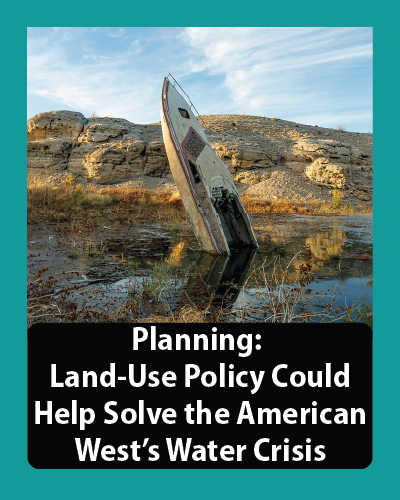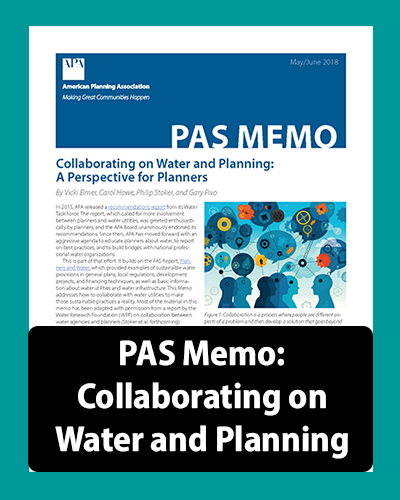Knowledgebase Collection
Integrated Water Resource Management

Integrated Water Resource Management (IWRM), also known as One Water, is an approach to managing water that looks holistically at the planning and management of water supply, wastewater, and stormwater systems. IWRM focuses on the water cycle as a single connected system and promotes coordinated development and management of water, land, and related resources to maximize the economic and social benefits while minimizing impacts on the environment.
From this page, you can search for resources that provide background, and policy guidance on integrated water resource management, as well as examples of regulations, reports, and functional plans. And you can filter these search results by resource type and various geographic characteristics.
Contents
Featured APA Resources
IWRM and the Water Cycle
Water exists in many forms—as lakes and rivers, glaciers and ice sheets, oceans and seas, underground aquifers, and vapor in the air and clouds. The water cycle (or hydrological cycle) describes the process through which water cycles in and out of the atmosphere – evaporating from the earth’s surface and falling again as precipitation. As water falls, it collects in waterbodies, and recharges ground water supplies. Urban development and the built environment impact the water cycle, altering patterns of drainage and runoff and affecting water quality and supply.
Traditionally, water supply, wastewater, and stormwater systems have been designed and managed separately. IWRM approaches the water-cycle as a single connected system and creates intentional linkages between water supply, wastewater, and stormwater systems and the utilities that manage them. It also looks systematically at other areas that impact water systems, including land use patterns, agriculture, and energy.
There are four central components of integrated water resource management: stormwater management, wastewater treatment, water supply, and conservation of existing water sources.
- Water Supply - Water for human use comes from two primary sources—surface water and groundwater. Water supply systems convey, store, treat, and distribute water. Understanding water use helps to evaluate the effects of future development on water supply sources.
- Wastewater Treatment - Wastewater is the byproduct household, industrial, and commercial uses of water. Wastewater management systems are designed to prevent waterborne pollutants from contaminating surface or groundwater sources. Increasingly, communities and wastewater utilities are beginning to view wastewater as a commodity with potential for resource recovery and reuse.
- Stormwater Management – Stormwater runoff results from precipitation as it flows over land or impervious surfaces. Runoff includes pollutants and toxins that can impair waterways. Stormwater systems include traditional grey infrastructure, such as storm sewers, as well as green or nature-based infrastructure.
- Conservation of existing water sources (Groundwater and source water) – Water conservation strategies are an important part of an IWRM approach. Water conservation measures address both indoor and outdoor water usage through regulations, education, outreach, and incentives.
IWRM and Planning
Water resources are impacted by decisions related to land use and growth management. These decisions influence water demand, affect water supply, and impact water quality. While planners have not traditionally worked directly on water and wastewater systems, they are often engaged in natural resources conservation and management, floodplain management, and green infrastructure projects. Increasingly, planners are working with collaboratively with water professionals and integrating water needs and challenges into local plans and regulations.
IWRM represents a paradigm shift in the management of water, both in terms of the physical systems that manage water and the institutional structures. Planners play a key role in facilitating implementation of IWRM efforts, which depend on interdisciplinary collaboration between water professionals, planners, engineers, landscape architects, public works professionals, and other related professions.
Related Collections
Capital Improvements Programming
Capital improvements programming is a plan implementation technique that involves prioritizing and scheduling investments in public facilities and infrastructure over a multi-year period. This collection catalogs resources that provide background and policy guidance or demonstrate how localities are using multi-year capital investment programs as plan implementation tools.
Environmentally Sensitive Areas
Environmentally sensitive areas (ESAs) are environmental features that are susceptible to adverse impacts from new development. This collection catalogs resources that provide background, policy guidance, or examples of local plans and regulations aimed at protecting environmentally sensitive areas.
Green Building
Green building encompasses a wide range of planning, design, and construction practices that seek to improve the environmental performance of buildings. This collection catalogs resources that provide background and policy guidance or demonstrate how cities and counties are using plans, regulations, and programs to require or incentivize green building practices.
Green Stormwater Infrastructure
Green stormwater infrastructure uses (or mimics) natural processes to reduce or treat stormwater runoff. This collection catalogs resources that provide background and policy or design guidance, as well as examples that demonstrate how localities are using plans, regulations, and programs to minimize dependence on gray infrastructure for stormwater management.
Hazard Mitigation
Hazard mitigation is any sustained action taken to reduce or eliminate the risk of property damage or injuries from natural or human-caused disasters. This collection catalogs resources that provide background and policy guidance or demonstrate how cities and counties are using plans, programs, and regulations to mitigate natural and human-caused hazard risks.










